Conquest: Cortes, Montezuma, and the Fall of Old Mexico by Hugh Thomas

Author:Hugh Thomas
Language: eng
Format: mobi
Publisher: Simon & Schuster
Published: 2013-04-16T07:00:00+00:00
So the journey went on, under Mt. Aztacuemecan, and past several menacing villages. Sometimes grass was the only food. The Castilians kept going, often travelling very few miles a day, always under attack. Several of their number died daily of wounds. They seem now to have been reduced to three hundred and forty soldiers, nearly all wounded in some way, and twenty-seven horsemen.26 Just beyond the famous Teotihuacan (whose ruins they could not see, since they were then covered with bushes and trees), they began to climb towards the northernmost pass over the mountains towards Tlaxcala, and reached a town called Otumba. In happier days, this place had been known for the obsidian found nearby, and for a story of how its governor, accused of a crime, composed a poem on his way to be judged by the King of Texcoco, Nezahualcoyotl: on his arrival he recited it to the King, who pardoned him forthwith.27
Here at last the new emperor, Cuitláhuac, having followed the Castilians in their retreat, appears to have decided to finish with Cortés and the conquistadors once and for all. So he had mounted a large force.28 He did not commit himself to commanding this army, however, but gave over that position to his deputy, the cihuacoatl.
The battle was exhausting for the conquistadors. As usual, the Mexica, with their obsidian-bladed swords, fought to capture and not to kill. So there were few Castilian fatalities. But the sheer numbers of the Mexica tired the already wearied ranks of Cortés’ army. They fought hand to hand for hours.29 The small band of surrounded Castilians seemed to have no chance of breaking out: “Truly our enemies . . . were innumerable,” wrote one observer;30 and “We could resist but feebly,” said Cortés in his report, “since we were tired and nearly all of us wounded and fainting from hunger.”31 By about noon, after several hours’ constant fighting, Cortés perceived that his men were flagging badly; “Our spirits were low,” recalled Gaspar de Garnica, a Vizcayan, one of Velázquez’s friends who had come to “New Spain” with Narváez.32
A decisive action was, therefore, necessary if the effort of the retreat were not going to seem wasted. Cortés himself provided it. He had seen for some time in the distance several Mexican captains, in glittering feathers. Contemporary accounts do not tell whether they were wearing the compressed quetzal feather insignia, the black and white feather sun insignia, or some other fine costume from the great wardrobe of Mexican military tunics.33 But they were resplendent. Leaving Ordaz in command of the infantrymen, Cortés took five horsemen (Sandoval, Olid, Alonso de Ávila, Alvarado and Juan de Salamanca, who came from Fontiveros near Ávila) to attack this group with lances. They rode straight at, and through, the undisciplined ranks of the Mexica and overwhelmed the surprised Mexican leaders.34 Mexican war costumes, cumbersome as well as heavy, were designed to overawe. They often came in five colours (to symbolise the four cardinal directions, and the centre). But these things had no effect on the Castilians.
Download
This site does not store any files on its server. We only index and link to content provided by other sites. Please contact the content providers to delete copyright contents if any and email us, we'll remove relevant links or contents immediately.
| Africa | Americas |
| Arctic & Antarctica | Asia |
| Australia & Oceania | Europe |
| Middle East | Russia |
| United States | World |
| Ancient Civilizations | Military |
| Historical Study & Educational Resources |
Cat's cradle by Kurt Vonnegut(15114)
Pimp by Iceberg Slim(14236)
4 3 2 1: A Novel by Paul Auster(12235)
Underground: A Human History of the Worlds Beneath Our Feet by Will Hunt(11986)
The Radium Girls by Kate Moore(11877)
Wiseguy by Nicholas Pileggi(5618)
Perfect Rhythm by Jae(5283)
American History Stories, Volume III (Yesterday's Classics) by Pratt Mara L(5218)
The Fire Next Time by James Baldwin(5207)
Paper Towns by Green John(5031)
Pale Blue Dot by Carl Sagan(4867)
A Higher Loyalty: Truth, Lies, and Leadership by James Comey(4803)
The Mayflower and the Pilgrims' New World by Nathaniel Philbrick(4383)
The Doomsday Machine by Daniel Ellsberg(4380)
Killers of the Flower Moon: The Osage Murders and the Birth of the FBI by David Grann(4355)
The Sympathizer by Viet Thanh Nguyen(4269)
Too Much and Not the Mood by Durga Chew-Bose(4237)
The Borden Murders by Sarah Miller(4197)
Sticky Fingers by Joe Hagan(4071)
